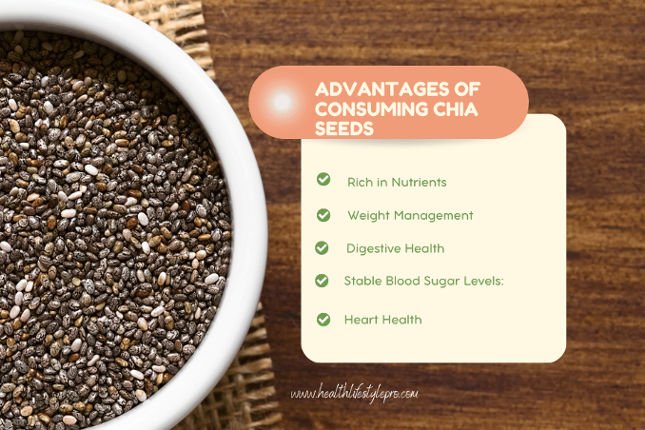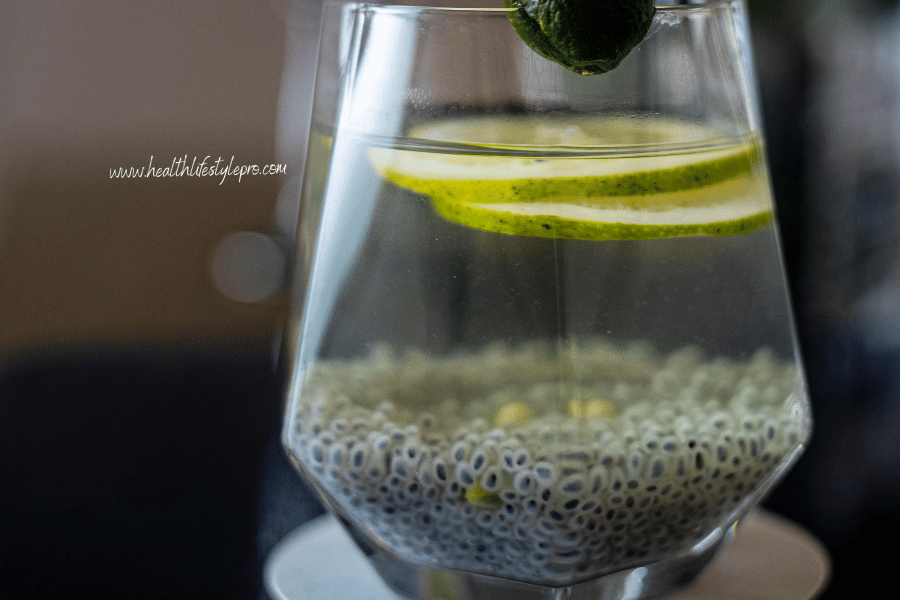In recent years, chia seeds have gained popularity as a superfood, lauded for their nutritional benefits. But what exactly happens to your body when you start incorporating it into your diet? In this comprehensive guide, we’ll delve into the remarkable effects chia seeds can have on your body, from head to toe.
The Nutritional Powerhouse of Chia Seeds
Before we explore the specific impacts on the body, let’s take a quick look at the nutritional profile of chia seeds:
| Nutrient | Amount per 1 oz (28g) |
|---|---|
| Calories | 138 |
| Protein | 4g |
| Fiber | 11g |
| Omega-3 Fatty Acids | 4,915mg |
| Calcium | 177mg |
| Iron | 2.2mg |
Now, let’s dive into the fascinating journey of what happens when you consume it regularly.
1. Improved Digestion
These are packed with soluble fiber, which can aid digestion.
Tip: Soak them in water before consuming them to enhance their digestibility.
2. Sustained Energy Levels
The combination of protein, fiber, and healthy fats provides a steady energy release.
Tip: Include it in your morning smoothie or yogurt for a nutritious energy boost.
3. Heart Health Boost
Omega-3 fatty acids contribute to heart health by reducing inflammation and improving cholesterol levels.
Tip: Sprinkle it on salads or incorporate them into heart-healthy recipes.
4. Balanced Blood Sugar
The fiber in it can help stabilize blood sugar levels.
Tip: Use it as a thickening agent in recipes instead of refined flour.
5. Hydration and Electrolyte Balance:
It can absorb water, aiding in hydration and electrolyte balance.
Tip: Create a chia seed drink by mixing them with water, lemon, and a hint of honey.
Advantages of Consuming Chia Seeds

1. Rich in Nutrients:
These are a nutritional powerhouse, containing essential nutrients like omega-3 fatty acids, protein, fiber, calcium, and iron.
2. Weight Management:
The high fiber content in it contributes to a feeling of fullness, potentially aiding management by reducing overall food intake.
3. Digestive Health:
The soluble fiber in it supports digestive health by promoting regular bowel movements and preventing constipation.
4. Stable Blood Sugar Levels:
It may help stabilize blood sugar levels, making them a beneficial addition to the diet for individuals with diabetes or those aiming to manage blood sugar.
5. Heart Health:
The omega-3 fatty acids in it have been linked to improved cardiovascular health, including reduced inflammation and improved cholesterol levels.
6. Vegan Protein Source:
These are an excellent plant-based protein source, making them a valuable addition to vegetarian and vegan diets.
7. Versatile Culinary Use:
These are versatile and can be easily incorporated into various dishes, such as smoothies, yogurt, salads, and desserts.
Disadvantages and Considerations
1. Caloric Density
While nutrient-dense, these are also calorie-dense. Excessive consumption without considering overall caloric intake may lead to unintended weight gain.
2. Digestive Issues
Some individuals may experience digestive discomfort, including bloating or gas, especially if these are consumed dry without adequate hydration.
3. Potential Allergies
Although rare, some people may be allergic to it. It’s advisable to start with small amounts and monitor for any allergic reactions.
4. Phytic Acid Content
It contains phytic acid, an anti-nutrient that may reduce the absorption of certain minerals. Soaking or sprouting can help mitigate this effect.
5. Hydration Considerations
It can absorb water and expand. It’s essential to consume them with sufficient liquids to prevent potential choking or discomfort.
6. Omega-3 to Omega-6 Balance
While it contains omega-3 fatty acids, the ratio to omega-6 is not as balanced. Maintaining a balanced omega-3 to omega-6 ratio in the diet is important for overall health.
7. Pricing
It can be relatively expensive compared to grains, which may impact accessibility for some individuals.
It’s important to note that individual responses to it can vary, and it’s advisable to consult with a healthcare professional or nutritionist, especially if you have any existing health conditions or concerns.
Future Trends in Chia Seed Consumption
Increased Demand for Plant-Based Proteins
As the popularity of plant-based diets continues to rise, being a rich source of plant-based protein, may see increased demand.
Growing Interest in Functional Foods
Consumers are increasingly seeking foods that offer health benefits beyond basic nutrition. Subsequently, Chia seeds, with their nutrient profile, maybe spotlighted as a functional food.
Innovation in Chia-Based Products
Anticipate a surge in innovative products, such as snacks, beverages, and baked goods, as the food industry capitalizes on the versatility of chia seeds.
Personalized Nutrition and Wellness
With a growing focus on personalized nutrition. For instance, it might be promoted for its adaptability to various dietary preferences and nutritional needs.
Sustainable and Ethical Sourcing
There could be a heightened emphasis on sustainable and ethical sourcing it, aligning with the broader trend of conscious consumerism.
Functional Ingredients in Beauty and Skincare
Given the potential benefits for skin health, it might find applications in the beauty and skincare industry as a functional ingredient.
Educational Campaigns on Proper Consumption
As it becomes more mainstream, expect educational campaigns on proper consumption, including soaking techniques and portion control.
Integration into Meal Kit Services
It might become a staple in meal kit services, offering convenient ways for individuals to incorporate them into their daily meals.
Research on Additional Health Benefits
Ongoing research may uncover new health benefits of, further fueling interest and consumption.
Chia Seeds vs. Flaxseeds
| Omega-3 Fatty Acids | Chia Seeds: Rich in alpha-linolenic acid (ALA), a type of omega-3 fatty acid. Flaxseeds: Also high in ALA, providing a similar omega-3 profile. |
| Fiber Content | Chia Seeds: High in soluble and insoluble fiber. Flaxseeds: Rich in both soluble and insoluble fiber, contributing to digestive health. |
| Nutrient Profile | Chia Seeds: Provide calcium, iron, magnesium, and phosphorus. Flaxseeds: Contain similar nutrients, with added benefits of lignans, known for their antioxidant properties. |
| Taste and Texture | Chia Seeds: Neutral taste, gel-like texture when soaked in liquid. Flaxseeds: Mild, nutty flavor, with a more subtle texture compared to chia seeds. |
| Ease of Digestion | Chia Seeds: Generally well-tolerated, especially when soaked. Flaxseeds: May need to be ground for better digestion and nutrient absorption |
Chia Seeds vs. Hemp Seeds
| Protein Content | Chia Seeds: Moderate protein content, suitable for plant-based diets. Hemp Seeds: Higher protein content, providing a complete source of essential amino acids. |
| Omega Fatty Acids | Chia Seeds: Rich in ALA (omega-3). Hemp Seeds: Balanced ratio of omega-3 and omega-6 fatty acids. |
| Nutrient Variety | Chia Seeds: Provide a diverse range of nutrients. Hemp Seeds: Rich in magnesium, iron, zinc, and other minerals. |
| Texture and Flavor | Chia Seeds: Gel-like texture, neutral taste. Hemp Seeds: Soft texture with a slightly nutty flavor. |
| Culinary Uses | Chia Seeds: Versatile, often used in puddings, smoothies, and baking. Hemp Seeds: Suitable as a topping for salads, yogurt, or as an ingredient in protein bars. |
Chia Seeds vs. Quinoa
Chia Seeds: Moderate protein content. | Quinoa: Considered a complete protein, containing all essential amino acids.Carbohydrates: |
| Chia Seeds: Lower in carbohydrates. | Quinoa: Higher in carbohydrates, providing a good energy source.Fiber Content: |
| Chia Seeds: High in fiber | Quinoa: Contains fiber but at a lower level compared to chia seeds. Cooking Tim |
| Chia Seeds: No cooking required; can be consumed raw or soaked. | Quinoa: Requires cooking, typically takes 15-20 minutes. Texture and Taste: |
| Chia Seeds: Gel-like texture when soaked, neutral taste. | Quinoa: Fluffy texture with a slightly nutty flavor. |
These comparisons highlight the nutritional differences and culinary uses of chia seeds about other popular seeds and grains
People Also Ask:
What happens if you drink chia seeds every day?
Regular consumption can lead to improved digestion, sustained energy, and enhanced nutrient absorption.
Do chia seeds reduce belly fat?
While they can aid in weight loss due to their filling nature, targeted fat reduction is influenced by overall diet and exercise.
What are the side effects of chia seeds?
Excessive intake may lead to digestive discomfort; moderation is key.
Is drinking chia seeds good for the skin?
Yes, the omega-3 fatty acids can contribute to healthy skin, reducing inflammation and promoting a radiant complexion.
Final thoughts
In conclusion, the journey of incorporating it into your diet is a transformative experience for your body. From enhancing digestion to promoting heart health and providing sustained energy, this is a nutritional powerhouse.
In this guide, we’ve only scratched the surface of the myriad benefits chia seeds offer. By making it a regular part of your diet, you embark on a delicious and health-boosting adventure.
So, what are you waiting for? Grab a spoon and start sprinkling those tiny seeds of wellness into your meals, and watch as your body thanks you with vitality and well-being.
Thus, Make the most of this nutrient-packed superfood, and savor the positive changes it brings to your life!

I’m a seasoned content creator with 6+ years of experience crafting engaging, SEO-optimized content that drives traffic and rankings. I excel in keyword research, link building, and guest posting, ensuring your brand reaches new heights.

